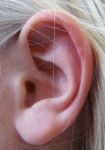Psychoacoustics & Music composition
Psychoacoustics is the study of subjective human perception of sounds.
Some of these tricks can be very useful in music composition and audio processing.
1st rule of psychoacoustics, human ear is not linear.
I mean, the perception of bass, medium and high frequencies are not equal at the same level. Human ear is more sensitive to medium frequencies, rather than high and bass. That's why you have to put more bass and high freq in the mix to "feel" it is ok. In the same idea, enhancers, bass boost equalizers and so put work that way, they fill the human lack...
2nd rule of psychoacoustics, the mask effect, a sound can hide another.
Not to be too technical, what you have to know is that human ear is sensitive by frequency bands. Scientists call them 1/3 octave bands running from 20Hz to 20kHz. If two sounds belong to the same 1/3 octave band, the louder will mask the other. This is called the mask effect. That is why when you mix music particularly you have to pay attention to the frequency repartition, in order to avoid this effect. For example the drum kick can easily mask the bass (and vice & versa).
octave bands running from 20Hz to 20kHz. If two sounds belong to the same 1/3 octave band, the louder will mask the other. This is called the mask effect. That is why when you mix music particularly you have to pay attention to the frequency repartition, in order to avoid this effect. For example the drum kick can easily mask the bass (and vice & versa).
This psychoacoustic aspect is used everyday in audio lossy compression such as mp3.
Other rules based on experiments, sometimes really weird but true... when psychoacoustics cheats your ears and fool your brain !
A red train is louder than a green train.
The Stapedius reflex
Stapedius reflex protects inner ear from agressions of too loud sounds. It also helps in voice recognition, when there is a lot of noise for example, because it automatically filters sounds under 2kHz.
The Doppler effect
One of the well reknown effects in psychoacoustics : The Doppler effect is the change in frequency of a sound for a moving sound source relative to the receiver (you). You can easily hear it when a vehicle sounding a siren approaches, passes and recedes from you.
The MacGurk effect
The MacGurk effect is an auditory illusion that illustrates well psychoacoustics. Your brain mixes informations from visual and hearing perceptions to create another new information. You "see" people saying da da da, but if you only hear it's a ba ba ba, and if you watch it's ga ga ga... a video explanation ?
The Shepard tone effect
A Shepard tone consists in a superposition of sine waves separated by octaves. When played with the base pitch of the tone moving upwards or downwards, this creates the auditory illusion of a tone that continually ascends or descends in pitch, and seems to get no higher or lower.like this... I love this one.
The tritone paradox
The tritone paradox is an auditory illusion of psychoacoustics discovered by Diana Deutsch in which a sequentially played pair of Shepard tones separated by an interval of a tritone, or half octave, is heard as ascending by some people and as descending by others.
Illusory continuity of tones
When a tone is interrupted for a very short time (like 50 ms) during which noise is played, the ear perceives the tone as continuous because of the mask effect (see upper) generated by the noise. It is called "the illusory continuity of tones".
Missing fundamental
We're talking about missing fundamental or phantom fundamental when the brain perceives the fundamental pitch of a tone whereas the sound lacks a component at the fundamental frequency itself. It is suggested to the brain by its overtones and the ration of its higher harmonics.
For instance, if a note (not a pure tone) has a pitch of 100 Hz, its frequency components will be 200,300,400,500 Hz... In most cases, small loudspeakers or headphones can't produce low frequencies, but a fundamental at 100 Hz can be heard whereas it is physically missing.
The octave illusion
from Wikipedia
Discovered by Diana Deutsch in 1973, the octave illusion is an auditory illusion produced by simultaneously playing two sequences of two notes that are spaced an octave apart, high to low, and low to high, in separate stereo channels over headphones. This pattern is almost never heard correctly, and instead gives rise to a number of illusions. Most people hear a single tone that switches between left and right ears while its pitch simultaneously switches back and forth between high and low. Most right-handers hear the high tone as on the right and the low tone as on the left. When the earphones are reversed most right-handers hear the same thing the tone that had appeared in the right ear still appears in the right ear and the tone that had appeared in the left ear still appears in the left ear.
Other people experience entirely different illusions; for example they may hear a single high tone in the left ear alternating with a single low tone in the right ear, or obtain complex perceptions that involve three or four tones of different pitch. Righthanders and lefthanders vary statistically in how they perceive the octave illusion, with left-handers less likely to hear the high tone on the right, and more likely to obtain complex perceptions.
So... as you can "see" there are a lot of way to cheat with audio as our ears are not perfect at all ! Psychoacoustics revealed via audio illusions is a smart way to realize this fact. It is a good start to understand and test these audio illusions around you to see that they really work.
There are a lot more to say about this topic... I hope I can take to some more time to go deeper on the subject.
But if you liked this page, you can either search on Google about psychoacoustics or come back later...
Go from psychoacoustics to Home ?
Go from psychoacoustics to Sound Branding ?
Leave your comments
So ? what you think ? Share with us about this article and leave your comments...
What Other Visitors Have Said
Click below to see contributions from other visitors to this page...
Tritone paradox is awesome ! Not rated yet
Hi !
just to tell you that Tritone paradox drives me mad !
great...
regards.
Manu




New! Comments
Have your say about what you just read! Leave me a comment in the box below.